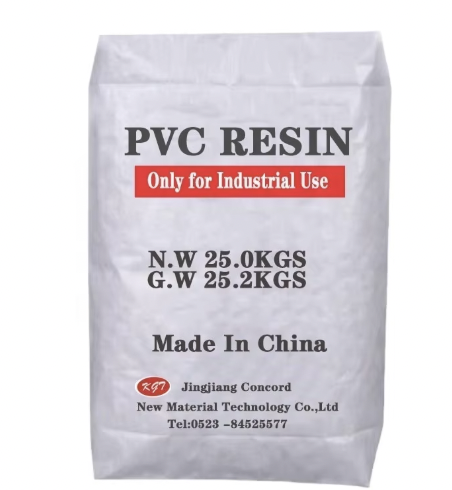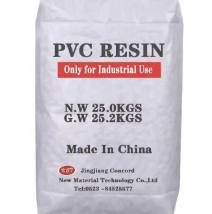Understanding PVC Resin Composition and Material Safety
How Resin Grades Influence Strength and Durability
PVC resin is available in different forms such as rigid, flexible, and impact-modified resins, which have their own characteristic mechanical properties and processing performance. The strong tensile strength of rigid PVC can make you find it perfect for some of its applications such as pipes and window frames. Flexible PVC is the soft type, and has a slightly softer rubber mixture, allowing for more stretch. High impact PVC provides toughness and durability while offering resistance to harsh environments. This value may vary depending of the type of PVC (it is know that rigid PVC is capable of reaching approximately 52 MPa and the flexible types are limited within 10-50 MPa) (ASTM). It can even impact on different grades of product, demonstrated by the successful use of high-impact PVC in outdoor signage, which is more weather resistant than its competitors.
Selecting K-Values for Rigidity and Processing Efficiency
More importantly, K-value is a big factor to influence the viscosity and processing properties of PVC resins. Basically, the K-value corresponds to the average composition of the number of polymerization of the content in the resin. Applications Choose a K-Value: The K-value chosen might vary depending on the degree of rigidity and processability required of the end product. Lower K-values translate into more fluid resins, thus more suitable for high-flow injection molding. By contrast with higher K-value end products of stiffer character, desired in applications where mechanical properties are more critical. For example, K-values in the 57-60 range are suitable for producing strong pipe with good rigidity and ease of processing. These standards assist industries and companies throughout the world in maintaining their products and services with quality to maximize structural integrity and efficiency.
Additives Impacting Toxicity and Environmental Safety
In the production of PVC, the use of additives such as plasticizers, stabilizers and fillers play a big role in the product safety as well as their environmental impact. platicizers are used to improve flexibility but can be a source of toxicity if not properly handled. Stabilizers enhance heat resistance and stability, whereas fillers modify physical properties and economy. Some additives have been shown to have potential negative health effects, so selection and regulation should progress cautiously. Phthalates and heavy metal stabilizers Recent attention has been drawn to the toxicity of some phthalates and heavy metal stabilizers. In order to guarantee safety, there ought to be no-poisonous non-toxiceco-pleasant additives used by manufacturers and comply with the international mark. Best practice would be to develop more sustainable inputs and reduce any overuse to allow environmental footprints to settle within current safety guidelines.”
FDA Compliance for Food-Contact Applications
Compliance with the FDA is critical in maintaining safety for PVC goods used in food-contact operation. The FDA's Code of Federal Regulations sets stringent guidelines that must be met to obtain clearance for the use of PVC in food-contact. Manufacturers go through an extensive approval process which is coupled with very thorough testing and extensive documentation and we must be able to prove that our PVC products are safe to be used in such a close and intimate proximity to food. Industry numbers show a wide range in compliance among manufacturers, some of whom face penalties if they do not comply, including recalls or bans. By reviewing case studies, you will find out that it's crucial to stay compliant with FDA guidelines or you'll be at risk of fines and consumer loss of trust.
EU REACH Chemical Safety Protocols
REACH, the EU’s system for synthesising and understanding information on chemicals in the EU, greatly affects PVC production and usage. It requires comprehensive chemical safety checks, and calls for substances used in PVC applications to be appropriately registered. This is an exercise to improve chemical safety throughout the EU and reduce the risks that dangerous substances pose to people and the environment. This can be costly and time consuming for manufacturers as they must update and maintain their material safety data in order to comply with changing standards. The complexity of REACH may create operation burdens and burdens cost, many of the requirements of which not only put forward the strict demand on PVC industry, in manufacturing process, but also constitutes a strong induction of the chemical safety and equal responsibility to the kind of operation of environment in the aspect by PVC and product distribution.
UL Certification for Electrical Conduit Systems
Underwriters Laboratories (UL) compliance is mandatory in PVC for Electrical conduit. Primary standards, such as UL 514B, define the requirements for the performance and the integrity of PVC in these services. Obtaining UL certification proves a product is safe and decreases the risks of electrical failures that can result from uncompliant materials. A large number of producers developed very well with the UL, and benefited a lot from the public image and the less responsibility undertaking. This is extremely important in the electrical industry - especially where both safe and dependable materials are a must.
NSF Standards for Potable Water Pipes
PVC use in potable water applications as per NSF standards are in question with various agencies including the EPA (Environmental Protection Agency), as it is not chemically stable for all water qualities and is not rated for hot water use. These standards establish test procedures and acceptance criteria primarily based on leachate tests to protect against contamination of water by PVC pipe. Such prevention is the more necessary in view of the danger that may arise if the National Sanitation Foundation ( NSP ) standards are not met; the non-fulfilment of standards will have serious consequences for public health. Manufacturers must strictly adhere to each of these guidelines to create PVC pipes perfectly safe for carrying potable water for humans. Failure to comply have underscored the dangers of over looking these calibration benchmarks, emphasizing the importance of strict adherence to NSF standards.
Analyzing EU's 2024 PVC Lead Phase-Out Mandates
The proposed 2024 EU regulations on lead in PVC products is a critical step for the protection of public health. Exposure to lead has long been known to pose serious health risks, from neurological and developmental effects to children. The good news is, the EU’s new directives will push manufacturers, hungry for access to the EU marketplace, to eliminate lead from PVC and innovate in order to meet those demands. Industies where PVC is used must meet the given time-bound; for non-compliance the penalties/straitjacketing to the market are so strict that operations may become extremely difficult for the businesses before 2024.
Calcium-Zinc Stabilizers as Viable Replacements
With the EU banning lead containing stabilizers in PVC, calcium-zinc stabilizer provide a viable alternative for it having a lower overall carbon footprint, with various reobust environmental and health benefits. These stabilisers replace hazardous lead-based products and offer non-hazardous, eco-friendly alternatives while retaining performance. They have thermal stability and processing performance equivalent to conventional stabilizers. A number of manufacturers have since made successful changes to calcium-zinc systems, as illustrated in a number of case studies showing improved safety and acceptance of their pellets in the marketplace. While they meet the rules, those shifts also mirror increasing consumer demands for safer, sustainable products.
Recycled PVC Compliance Challenges
There are unique challenges in verifying that recycled PVC meets the lead content limits. It is technically complex to verify the safety of recycled materials, in particular according to modern recycling techniques. Practical methods for the detection and removal of lead contamination are also possible to gain compliance. On-going studies draw attention to progress with recycling techniques which were designed to overcome these issues. Robust safety checks and investment in advanced recycling technologies would help manufacturers to comply with the lead restrictions and to access greater markets, and support sustainable production processes.
Medical Device Manufacturing: USP Class VI Compliance
PVC-based materials utilized in medical products must be USP Class VI compliant in order to be both safe and effective. This compliance is substantiated by rigorous cytotoxicity testing and other testing to ensure that materials do not pose any risk to human health. By way of example studies, we also point out the reliable and clinical safe use of flexible PVC in life-critical products like catheters and blood bags. Compliance with such regulations is a necessity for manufacturers with an interest in accessing the medical market, as a failure to meet these requirements may result in high liabilities and a restriction of market entry for vital health products.
Potable Water Systems: NSF/ANSI 61 Validation
NSF/ANSI 61 certification is critical for PVC potable water system components to ensure the products do not contribute harmful contaminants to drinking water. This involves rigorous testing to check the materials for health safety and ensure they are suitable for being constantly wetted. In some case studies exposed, non-compliant materials can have serious impact for human health and especially harmful for potable drinking water distribution network in parts of they have been contaminated. Certification of materials is vital for public health protection, protecting communities from potential risks, and ensuring safe drinking water for all.
Construction Materials: Fire Safety Ratings
Fire safety performance is of particular importance for PVC as construction material in flame spread and smoke generation in case of a fire. Data from safety groups reveals that the incorrect use of materials can result in more fires, which is why it is critical to comply with the standards. Fire performance of PVC materials has improved with some materials exhibiting resistance while still remaining compliant. These developments have raised the profile of using PVC materials that comply with rigorous fire standards to safeguard life and property in construction.

Bio-Based Plasticizers for Reduced Toxicity
But the rise of bio-based plasticizers is revolutionizing advances in PVC safety by offering a safe alternative to phthalates. Classical pthalates were already suspected to potentially cause health hazards, and scientists are therefore looking into bio-based alternatives with lower toxicity. The performance of some bio-based plasticizers in checking flexibility and durability are also impressive and also the overall product safety is significantly increased. Indeed, some businesses are already making the transition and implementing these alternatives into their production lines, resulting in increased acceptability of the resulting products from the market.
Molecularly Oriented PVC (PVC-O) Advancements
Molecularly Oriented PVC (PVC-O) is the next generation of PVC pipe technology with improved mechanical performance, durability and environmental benefits, and it is the best environmental performer in use - with significantly lower global warming potential, acidification potential and eco-indicator as impact of ozone (e.I.只asAP-Ozone) than nearly all other pipeline materials. Increasing demand for PVC-O can be attributed to the replacing of conventional PVC alternatives, more specifically from those applications that need better performance such as pipes, tubing and building materials. An investigation shows that PVC-O has higher impact strength and tensile strength that attributes as a material with challenging applications. Also its sustainability features – e.g. less material use, higher lifetime – are triggering demand well across the industry.
Digital Tracking for Supply Chain Transparency
Digital monitoring solutions have become vital for innovation in the PVC industry to improve transparency in the supply chain. Such technologies also offer advantages such as enhanced traceability and accountability, ensuring it is the case that every phase of the supply chain adheres to safety and quality regulations. Case studies demonstrate how digital tracking is helping maintain safety compliance, minimizing the threat of non-compliance when producing PVC. In the future, the industry will increasingly adopt digital tech to check for product safety and sustainability, the fact sheet said, hence the important role it is predicted to play in future PVC operations.
FAQ
What are the key PVC resin grades?
PVC resin grades include rigid, flexible, and high-impact variants, each offering unique mechanical properties and performance benefits for different applications.
Why are K-values important in PVC resins?
K-values determine the viscosity and processing characteristics of PVC resins, affecting the rigidity and ease of manufacturing processes for various industrial applications.
How do additives impact PVC safety and environmental impact?
Additives like plasticizers, stabilizers, and fillers affect PVC's safety and environmental footprint. Choosing eco-friendly alternatives is crucial for minimizing health risks and adhering to regulatory standards.
What are EU's 2024 PVC lead phase-out mandates?
The EU aims to phase out lead content in PVC by 2024 to protect public health, requiring manufacturers to adopt alternative stabilizers like calcium-zinc.
What role does UL certification play for PVC in electrical applications?
UL certification ensures the safety of PVC in electrical conduit systems, validating product reliability and reducing the risk of electrical failures.
How do bio-based plasticizers benefit PVC safety innovations?
Bio-based plasticizers offer reduced toxicity compared to traditional phthalates, improving flexibility and product safety without compromising performance.
Table of Contents
-
Understanding PVC Resin Composition and Material Safety
- How Resin Grades Influence Strength and Durability
- Selecting K-Values for Rigidity and Processing Efficiency
- Additives Impacting Toxicity and Environmental Safety
- FDA Compliance for Food-Contact Applications
- EU REACH Chemical Safety Protocols
- UL Certification for Electrical Conduit Systems
- NSF Standards for Potable Water Pipes
- Analyzing EU's 2024 PVC Lead Phase-Out Mandates
- Calcium-Zinc Stabilizers as Viable Replacements
- Recycled PVC Compliance Challenges
- Medical Device Manufacturing: USP Class VI Compliance
- Potable Water Systems: NSF/ANSI 61 Validation
- Construction Materials: Fire Safety Ratings
- Bio-Based Plasticizers for Reduced Toxicity
- Molecularly Oriented PVC (PVC-O) Advancements
- Digital Tracking for Supply Chain Transparency
- FAQ

